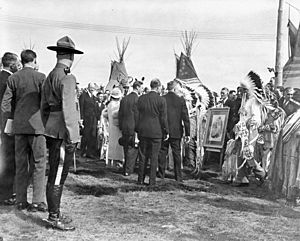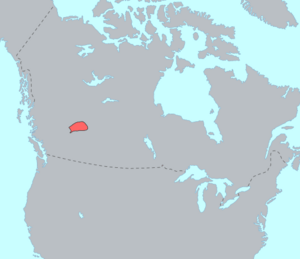Paul Band facts for kids
| Treaty | Treaty 6 |
|---|---|
| Headquarters | Duffield |
| Province | Alberta |
| Land | |
| Main reserve | Wabamun 133A |
| Other reserve(s) | |
| Land area | 73.306 km2 |
| Population (2022) | |
| On reserve | 1334 |
| Off reserve | 842 |
| Total population | 2176 |
| Government | |
| Chief | Arthur Rain |
| Website | |
| http://www.paulfirstnation.com/ | |
The Paul First Nation, also known as the Paul Band, is a First Nations group located in Wabamun, Alberta. Their heritage comes from both the Cree and Nakoda (Stoney) peoples. They are part of Treaty Six, an agreement signed with the government. In 1892, they were given lands called Buck Lake Indian Reserve 133C and Wabamun Lake Indian Reserve 133A, 133B, and 133C. Sadly, many people on the Buck Lake Reserve got very sick during the Spanish Flu of 1918 pandemic, and the area is now mostly empty.
As of 2005, the Paul First Nation had 1,926 members. About 1,110 of these members lived on their reserve lands.
The Paul Band's lands, Wabamun 133A and 133B, are located along Lake Wabamun. This is about 70 kilometers (43 miles) west of Edmonton. Lake Wabamun is a popular spot for people in Alberta to visit on weekends and holidays. The Paul Band runs the Ironhead Golf and Country Club to welcome these visitors.
In April 2010, a large and expensive wildfire forced many community members to leave their homes for safety.
Contents
Who Are the Paul First Nation?
The Paul Band signed a treaty in 1876 and settled near the eastern side of Lake Wabamun. In 1996, the total population of the Paul Band was 1,397 people. Out of these, 856 lived on the Paul Band Reserve. By 1998, there were 1,400 members of the Paul First Nation. Most of them were Stoney, and the rest were Cree.
In Alberta, the Nakoda people are known as Stoney. They were also sometimes called Assiniboine by the Cree. All these groups speak a common Siouan language. However, there are small differences in the way the language is spoken among groups in Alberta, and between those in Alberta and those in Saskatchewan and Montana.
A Look at Their History

The Stoney people are descendants of different groups like the Dakota, Lakota, and Nakota. They especially came from western groups of the Assiniboine. The Stoney became their own independent group around 1744. They were divided into two main groups based on where they lived and their culture, and each of these had smaller bands. These groups spoke different dialects of their language.
The Paul Band and the Alexis Band were the farthest north and west of all the Siouan-speaking groups. Experts have different ideas about where the Paul and Alexis Bands were located before the treaties were signed. Some ideas suggest they moved west along the edge of the northern Plains. Others think they might have been in this area even before they had horses.
By 1880, about half of the Alexis Band, led by a man named Ironhead, moved away. They settled at Wabamun Lake because the land and fishing were better there. The Alexis Band had been given different lands as a reserve when they signed Treaty Six in 1876. The chief of the Alexis Band was Catholic and did not like other religions. The group at Wabamun Lake was Protestant.
By 1892, the government realized that the Alexis and Wabamun Lake bands had too many differences to live together. So, they created a second reserve for the Paul Band at White Whale Lake. The reserve's name was later changed to Wabamun Lake Indian Reserve. The Paul Band was named after the head man at that time, Paul. According to government records, Paul's brother, Ironhead, had led them to Wabamun Lake. However, Ironhead passed away before the reserve was officially created. The reserve was called Wabamun Lake Indian Reserve, and the group was called Paul Band. Over time, the reserve became popularly known as Paul Band.
About Wabamun Lake
Ironhead moved his band to Wabamun Lake by 1880 because it was a great place for fishing. The area around the lake has rolling hills with aspen trees and good land.
Around 1850, a mission at Lac Ste. Anne started fishing in nearby lakes. They would then provide fish to people in Edmonton.
By 2003, a scientist named David Schindler described Lake Wabamun as one of the most used lakes in Alberta. It is also one of the most popular lakes for recreation in Alberta.
The Paul Band First Nation Reserve is on the east side of the lake. There is also a village called Wabamun, along with several summer villages and neighborhoods along the lake shore. The Yellowhead Highway and CNR railroad tracks run along the north shore. There are also coal mines north and south of the lake. In the past, there were power plants like TransAlta's Wabamun (now closed) and Sundance, with cooling ponds for Sundance and Keephills power plants. You can also find Wabamun Lake Provincial Park at Moonlight Bay and a golf course managed by the Paul Band First Nation Reserve.
Since 1912, the water levels of Lake Wabamun have been changed many times, sometimes illegally. Different groups wanted to control the lake levels, either making them very high or very low.
About 22% of the land that drains into Lake Wabamun has been affected by two coal mines: the Highvale mine and the Whitewood mine. The Highvale mine covers 12,600 hectares (31,135 acres) and is the largest coal mine in Canada. Strip mining involves removing the top layers of earth to get to the coal underneath. By 2004, these two mines had disturbed 5,593 hectares (13,820 acres) of the land that drains into Lake Wabamun.
Most of the coal burning in Alberta happens about 70 kilometers (43 miles) west of Edmonton, in the Wabamun Lake area. The Wabamun Generating Station, a coal-fired power plant owned by TransAlta, was located next to the village of Wabamun, Alberta. It started operating in 1956 and was closed in 2010. Its tall smokestacks were taken down in March 2011. The plant got its coal from the Whitewood mine.
According to a 2003 report by David Schindler, the coal-fired power plants near Wabamun Lake released a lot of pollution. They emitted 65% of the airborne mercury from industrial sources in Alberta. They also released other metals, sulfates, tiny particles, water vapor, nitrogen oxides, and polycyclic aromatic hydrocarbons. About 74% of Alberta's carbon dioxide (CO2) emissions from coal power plants came from the plants near Lake Wabamun.
Even though mercury levels in fish from the lake were generally safe for occasional eating, Schindler warned that for the Paul Band members who eat fish regularly, there might be some concern. This was especially true for large Northern pike from Lake Wabamun, which could have higher mercury levels.
On August 3, 2005, over 1.3 million liters (343,424 US gallons) of bunker oil and other chemicals spilled into Lake Wabamun. This happened when faulty tracks caused 40 train cars to derail in Wabamun village. Two years later, health warnings were still in place. People were advised to avoid oil patches and tar balls in Lake Wabamun.
Learning and Education
In the summer of 1893, the White Whale Lake Methodist Day School opened at the Paul Band reserve. It was run by the local Methodist missionary. In the fall of 1893, the Methodist Church also started operating the Red Deer Methodist Indian Industrial School.
Children of school age from the Paul Band attended the Edmonton Residential School and the St. Albert Residential School. This was roughly between the years 1923 and 1950.
Community Challenges
In 2011, the Paul Band faced a $3 million budget shortfall. This led to the shutdown of many important community services. For example, school buses and transportation for medical appointments were stopped. In 2011, the band's estimated budget was $14 million. They received $8.5 million from Aboriginal Affairs and Northern Development Canada.
In 2001, the Band had to work with a co-manager to help manage their finances. Budgets for First Nations are set by the band but approved by the government in Ottawa. These budgets are based on how much money the band made in previous years. If oil and gas money from the band's Buck Lake property changes a lot, it can affect how much money the band gets from the government. Other challenges include a high demand for housing and the need for road repairs. Also, the community had recently been evacuated due to wildfires.
See also


